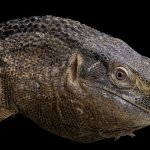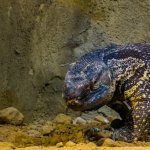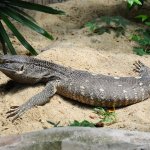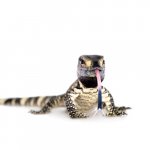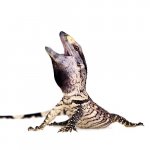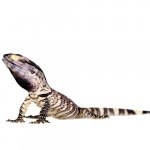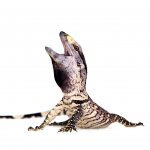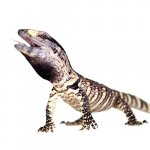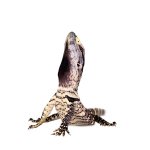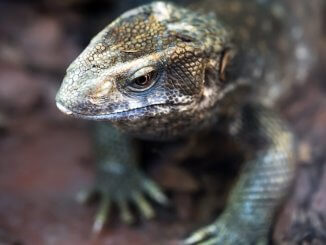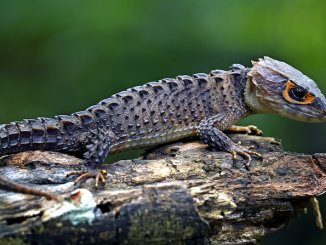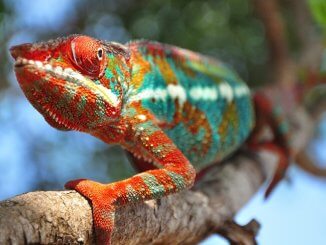Introduction
As one of the largest lizards in the world, it is easy to see why people are so fascinated by black-throated monitors. Black-throated monitor lizards look prehistoric giants. They are highly intelligent, can grow larger than humans are tall, and can be almost as affectionate as a cat or a dog if socialized properly.
They are one of the most docile species of African monitor lizards, and if it weren’t for their giant size, would actually make good pet reptiles for beginners. However, due to their incredibly costly setup and how hard they can become to manage if you aren’t familiar with how to socialize and work with large lizards, this is a species we recommend for experienced reptile keepers only.
In this article, we will cover basic husbandry of the black-throated monitor, common behaviors you are likely to see, how to socialize and handle your giant lizard, and cover some of the common health issues the monitor may experience as well as how to prevent them.
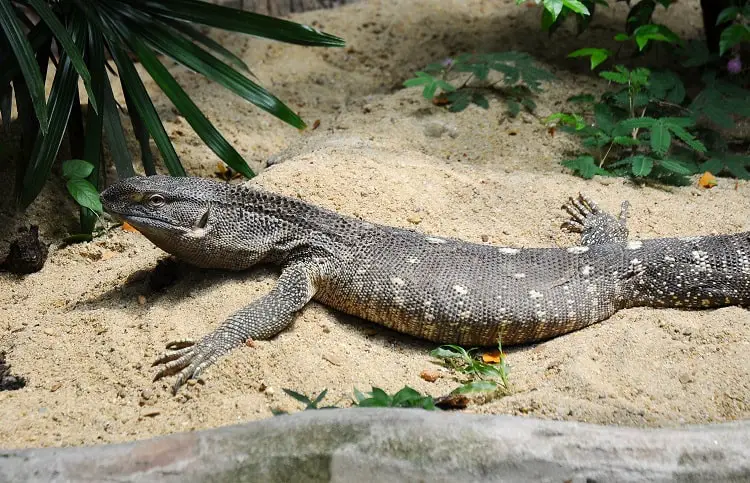
Black-Throated Monitor Overview
The black-throated monitor lizard, scientific name Varanus albigularis ionidesi, is one of three subspecies of the rock or cape monitor. Subspecies are animals that are too genetically similar to a species to be classified as a separate species, but are also genetically distinct enough to be given a classification of their own.
The white-throated iguana, black-throated iguana, and Angolan white-throated monitor are all a subspecies of the rock monitor. The black-throated monitor can grow to be larger than the other two subspecies, reaching lengths of up to 7 ft. long and weighing up to 60 lbs.
This beast of a lizard belongs to the Varanidae family, which is the monitor lizard family. Black-throated monitors are native to the east-African country of Tanzania and are seen in arid areas such as the savanna or bushy, forested locations.
Black-throated monitors can live up to 25 years in captivity, so be sure you are ready for this type of commitment if you are considering purchasing one. The black-throated monitor gets its name from the black color of the throat. Black-throated monitors are usually mottled brown or gray with white or yellow markings along the body and a blunt, almost potato-shaped head.
Its forked tongue can be either pink or bluer in color, and is seen often since the monitor lizards use their tongues like a snake would – to pick up any interesting scents in the area. Black-throated monitors are diurnal and spend most of their time roaming their territory in search of food. They are carnivorous and have a diet that consists of carrion as well as prey that they hunt and kill themselves.
While black-throated monitors look very intimidating, they can actually make quite good pets if you socialize them at a young age. There are many reports of people litter-training their black-throated monitors, teaching them to come when called, and teaching them to do other tricks just like you could a cat or dog.
Despite their generally calm demeanor, this is still a species that should only be kept by very experienced reptile keepers, as they could severely injure or even kill you if they really tried. Black-throated monitors have incredibly powerful legs and jaws, making them fast hunters that can deal a lot of damage in a single bite or blow from the claws.
They also have a very powerful tail that they can use as a whip, similar to the iguana. A single bite could send you to the hospital for several stitches or could easily remove fingers or toes, so learning to read body language and understanding how to handle large lizards is absolutely vital if keeping a black-throated monitor.
This is not a species that should be kept by anyone who has young children. Black-throated monitors are not known to be quick to bite or otherwise harm you, but in dealing with such large animals, extreme caution is always advised.
If you decide that you do want to attempt keeping one of these massive lizards, it is absolutely necessary to do an immense amount of research on setting up the habitat. Many people forgo an enclosure entirely and instead let their black-throated monitor roam the house freely like a dog would. However, if you are determined to keep them in an enclosed space, you will need an enclosure that is, at the very minimum, 6-7ft long for an adult.
A large bedroom would also suffice. Black-throated monitors like to roam, so they need plenty of space to walk around and explore. Because they are so highly intelligent, their enclosure or home needs to include areas in which they can dig, overturn rocks, and keep themselves entertained. Providing them with puzzles they need to solve in order to get to their food is a fantastic idea to keep your monitor’s brain stimulated.
A bored black-throated monitor can become very grouchy and destructive, so enrichment is a necessity. Black-throated monitors will also require multiple heat lamps and UVB bulbs, so be prepared to spend a lot of money on your electricity bill each month. If your monitor is being kept in an enclosure, a loose substrate like coconut fiber, eco-earth, or some type of soil is best to allow them to dig.
Many of these monitors also like to have access to a water source large enough to fit their body into, so plan accordingly. A kiddie pool or a specialized habitat that includes a pond is ideal. Humidity is not as big of an issue with monitors as it is with other reptile species. 20%-50% humidity should be your target range, and the insides of most homes are already around this level. Just make sure to invest in a hygrometer to keep track of humidity inside the enclosure itself.
Getting To Know the Black-Throated Monitor {Pros vs Cons Comparison}
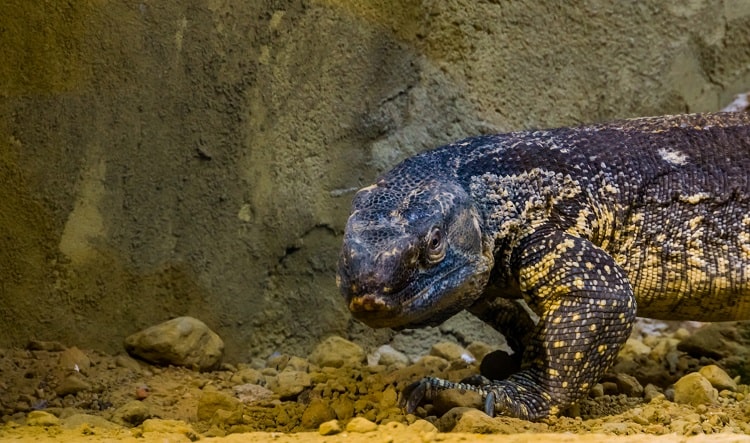
Pros
- Black-throated monitors are highly intelligent
- This is one of the most docile African monitor species
- Black-throated monitors can live up to 25 years, so they will be your companion for about a quarter of your life
Cons
- Black-throated monitors’ wild populations are declining
- Black-throated monitors can do severe damage to a human
- Black-throated monitors are massive and require larger enclosures than most people can provide
Appearance
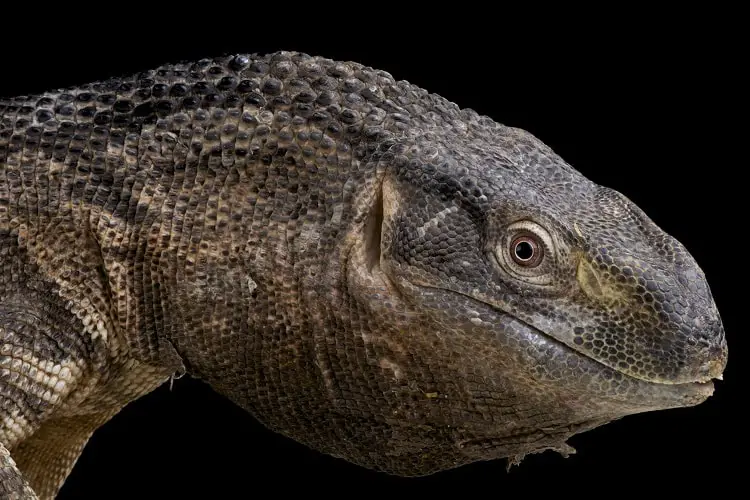
In terms of appearance, the black-throated monitor looks similar to a much larger version of a savannah monitor. The black-throated monitor gets its name from the dark patch of scales that cover the throat. This distinguishes the black-throated monitor from the other two rock monitor subspecies, both of which have a white patch on the throat.
The black-throated monitor is usually a mottled gray or brown with white or yellowed markings. This monitor’s massive body is covered in raised, bumpy scales that help make it look even more like a dinosaur. The leathery skin of the black-throated monitor is prized by many in Africa to make various items. Because of this, the black-throated monitor is considered threatened.
This massive monitor has a forked, snake-like tongue that is either pink or blue in color. In addition to appearance, it is also similar to a snake’s tongue in that they use it to taste the air for different scents. It helps them to track and locate their prey, which they will chase for miles. While monitors may look bulky and slow, they can actually move quite quickly. Their powerful leg muscles help support their massive bodies.
Black-throated monitors do exhibit slight sexual dimorphism, meaning there are differences in appearance between males and females aside from their reproductive organs. Males are usually larger than females. However, it is nearly impossible to tell the difference between males and females without having a professional probe your monitor to determine the presence or absence of male sexual organs or having your veterinarian perform an x-ray or ultrasound.
Many people recommend watching your monitor defecate. If a purple bulge appears while your monitor is defecating, you may be seeing the male reproductive organs.
Care & Husbandry Guide
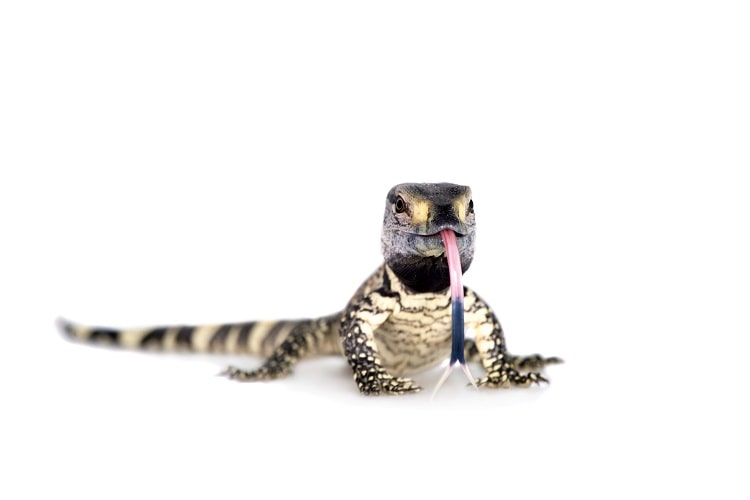
Black-throated monitors are very expensive pets to keep. Due to how large they are, they require an extensive lighting setup, a lot of food, and a massive, custom-built enclosure for adults. The black-throated monitor lizard is a species best suited for a household with no young children, cats, or dogs.
They grow to be incredibly large and incredibly powerful and could severely injure or kill a child or another pet. Black-throated monitors are very difficult pets to properly care for, but with the right keeper, they can make very intelligent and affectionate pets.
What To Feed A Black-Throated Monitor?
Black-throated monitor lizards are carnivores with a voracious appetite. They spend the majority of their time in the wild hunting.
Black-throated monitors are opportunistic feeders, meaning they will take down whatever prey crosses their path. They are not picky. They catch their prey by chasing it down. Contrary to what most people believe, these monitors can move very quickly.
They will chase their prey all across their home range, which can be up to 7 miles for adult males.
They prey on anything they can catch, including but not limited to rodents, birds, small mammals, insects, eggs, snakes, lizards, fish, and other aquatic animals. In captivity, most people feed their black-throated monitor rodents. However, it is important to provide these animals with a varied diet.
Changing up the diet will make your monitor more interested in food, gives it a wider variety of nutrients, and more closely mimics their wild diets. You can feed your black-throated monitor rodents, hard-boiled eggs, fish, insects, rabbits, chickens, crustaceans, lizards, and even snakes.
When sourcing food for your black-throated monitor, there are two main things to keep in mind: feed prey only purchased from a pet store or website, and feed pre-killed prey. Anything you catch from the wild could potentially be harboring diseases or parasites that could be harmful to your monitor, which is why buying prey specifically bred to be fed to reptiles or other exotic pets is so important.
Buying pre-killed prey is also important, because rodents, birds, and other prey items can cause a good bit of damage to your lizard if they bite. There are many documented cases of people’s pet reptiles dying from an infection caused by being bitten by prey.
Baby and juvenile black-throated monitors should be fed daily. Any insects you offer should be gut-loaded and dusted with a calcium powder supplement. Adult black-throated monitors can be fed smaller meals daily, or larger meals every other day. After adopting your black-throated monitor, you should speak with your veterinarian to determine the best feeding schedule as well as how much to feed.
Black-Throated Monitor Food List:
- Mice
- Rats
- Fish
- Eggs
- Crustaceans
- Crickets
- Roaches
- Baby chickens
Black-Throated Monitor Lifespan & Health Concerns
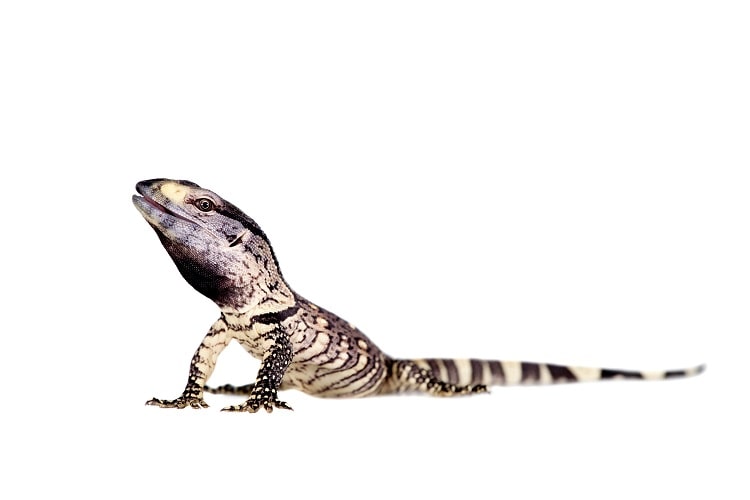
Black-throated monitors, if taken care of properly, can live over 20 years in captivity. They are not susceptible to many diseases, so the main health issues to watch out for usually come from improper diet or improper husbandry.
The wrong diet or overfeeding can wreak havoc on a reptile’s body. One of the main health concerns resulting from a poor diet is fatty liver disease, also known as hepatic lipidosis. Fatty liver disease is most commonly caused by overfeeding, or by feeding only high-fat prey.
Mice as well as certain species of fish, like goldfish, contain a lot of fat, and should be fed in moderation. Rats are generally a much better alternative to mice. Annual visits to your veterinarian will allow you to make sure that your monitor does not develop fatty liver disease. If your pet begins losing weight or has a poor body condition, you should immediately take it to a vet for bloodwork in addition to other tests to check for this disease.
One of the other biggest health concerns is metabolic bone disease, one of the most common health issues in all reptile species. Metabolic bone disease is caused by low calcium. If your reptile does not have access to both a source of calcium and UVB, which helps reptiles to synthesize and absorb calcium, the body can begin to leech the calcium from the bones instead.
This can cause deformities, weakened bones that are more prone to fracturing, loss of muscle tone, seizures, and, if left untreated long enough, will eventually cause death. This disease is easily avoided by providing proper UVB lighting as well as a calcium powder supplement that can be dusted onto insects. Your black-throated monitor will also be able to get calcium from the bones of small mammals it eats.
The final health concern we will cover for black-throated monitors is a gastrointestinal obstruction. These lizards have a voracious appetite, which can lead to them swallowing things that they shouldn’t. If they eat something that is too large or something indigestible, it can become lodged somewhere in the GI tract and prevent anything from passing. Obstructions can quickly turn fatal if not treated quickly.
If you suspect your monitor has eaten something it shouldn’t have, you will need to take it to a veterinarian immediately to have it x-rayed or have an ultrasound. This will allow the vet to determine if the object is blocking anything or will need to be removed surgically.
Signs They Are Healthy & Happy
- The black-throated monitor has a very healthy appetite
- The monitor has bright eyes, is alert, and moves around regularly
- Your monitor sheds regularly (about once a month)
- Your monitor has normal bowel movements
Sickness Symptoms
- The black-throated monitor is lethargic or does not seem interested in eating
- Your monitor has diarrhea or cannot pass stool
- The black-throated monitor is not breathing normally or has pus or mucus in the mouth
- Your monitor has small, white organisms that look like grains of rice of spaghetti in the feces (signs of parasites)
How To Set Up A Black-Throated Monitor’s Habitat?
Researching your pet’s native habitat is the key to setting up a fantastic enclosure that will mimic their natural environment as closely as possible. Black-throated monitor lizards are found in east Africa, so high heat and proper UVB lighting is needed.
They spend most of their time on the ground, but juveniles do like to climb, so keep this in mind when setting up your monitor’s enclosure. You will also need to provide a regular day/night light cycle to keep your monitor happy and healthy.
Because the black-throated monitor can approach lengths of 6.5 to 7 feet, the enclosure needs to be absolutely massive. This is one of the main reasons more people don’t keep these lizards. When selecting an enclosure, your monitor needs to, at the very minimum, have space to fully stretch out in any direction and take a few steps.
Black-throated monitors tend to wander around a lot in the wild, so to keep your monitor happy, you will want an enclosure that is a minimum of 6-7 ft long. Many people, rather than paying thousands of dollars to have a custom enclosure of that size built, choose to give their monitor lizard an entire room in the house or just let it roam the household freely.
This works well since monitor lizards only require a humidity of 20%-50%, which is the humidity level in most homes. If you do choose to go with a custom-built enclosure, you will want a substrate such as eco-earth or coconut fiber. This is loose and will allow your monitor to dig. Monitor lizards are highly intelligent and require a lot of mental stimulation. Providing a loose substrate for digging in addition to some different rocks and logs that your monitor can flip will give them something they can do throughout the day.
If you do not use an enclosure and instead let the lizard freely roam, make sure to provide different puzzles that your monitor needs to solve to get their food. Some studies have also found that black-throated monitors enjoy playing with various toys or other objects, so you may want to look into also purchasing objects for your monitor to play with.
Heating and UVB are arguably the most important aspects of your monitor’s habitat. Because they are from Africa, black-throated monitors need a basking spot (also known as a hot spot) that is about 100-110 degrees F, and an ambient temperature of 85-90 degrees F. The temperature should never drop below about 78 degrees. Reptiles cannot regulate their own body temperatures, so letting the temperature drop too low can be harmful to your reptile.
During the day, heat lamps make the best heat source, since this most closely mimics the sun and will do a better job of creating a hot basking spot. However, for nighttime, you may also want to invest in a heating mat to help keep the tank above 78 degrees.
The heating setup for these monitors can get quite expensive, because you will need multiple heating lamps to create a proper basking spot. If you use only one heat lamp for such a large lizard, they will stay under the heat lamp longer because it will take longer to heat up their whole body.
Staying there that long can cause a severe burn on the reptile, so using a cluster of lamps is necessary. For an adult black-throated monitor, 3-4 lamps should be sufficient. You will also need 3-4 UVB bulbs to ensure that your lizard is getting enough UV rays, which they need to synthesize calcium. Not having access to proper UVB will eventually kill your reptile, so this is not optional.
Finally, you will need some equipment. You will want at least 2 thermometers for the enclosure, one to be placed under the hot spot and one to be placed on the opposite end of the tank to read the ambient temperature. You will also need a water dish large enough for your lizard to soak in, a pair of feeding tongs to keep your lizard from nipping your fingers during feeding, rocks for your lizard to flip over, a large structure for your lizard to hide in, and fake or real plants to help create cover for your lizard.
Black-Throated Monitor Behavior
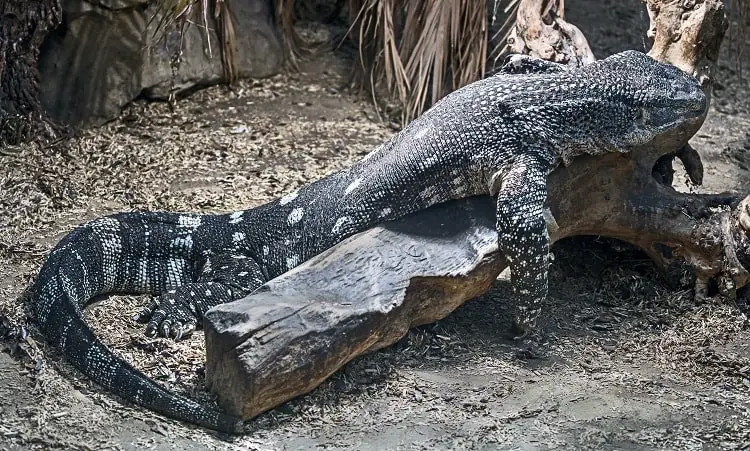
Black-throated monitors are pretty docile compared to other African monitor species, but they can still be quite ornery or grouchy at times. Because of their size, it is absolutely vital for your safety to understand warning signs that your monitor may be in a bad mood.
A bite from this monitor can easily take off a finger or send you to the hospital for stitches. When monitor lizards are angry, there are typically three major warnings that they give you before they bite. First, they will puff up their bodies in an attempt to appear larger.
This is a sign that your monitor is afraid of you or is trying to intimidate you. If puffing their bodies out does not work, then they will hiss and make other noises to tell you to back off. If your monitor is hissing at you, you need to back off and leave them alone.
Their next warning will not be as forgiving. Finally, if you still ignore the monitor’s warnings, they may whip their tails at you or lunge at you. A lash from an adult black-throated monitor’s tail can be quite painful. Their tails are very muscular.
If your monitor is displaying any of the above signs of irritation, it is best to back off and leave them alone until they are in a better mood. Signs of a relaxed or happy monitor include lounging with their legs extended out behind them, if they approach you with their tongues flicking rather than puffing up or hissing, or if they show little to no reaction to you approaching them.
Handling Safety
To handle your black-throated monitor safely, it is best to purchase them as babies. At their small, hatchling size, a bite or tail whip will not be as dangerous as from a juvenile or adult. It is much easier to socialize a young monitor than an adult.
After purchasing your monitor, start with 2-3 very short handling sessions each day, picking up your monitor and gently touching their tails and bodies. If they show signs of stress (squeezing their eyes shut, hissing, puffing up), place them back into their enclosure, offer an insect or pinky mouse as a treat, and try again later. Doing this daily will desensitize them to your touch, and in time, your monitor may even begin to like being held or scratched.
As adults, if you need to handle them, you can carry a monitor like you would a cat (held tightly to your body to prevent them from being able to thrash around and hurt you). You can also use their tails to help gain control over them, since monitors are unable to drop their tails. Many people take advantage of this if their monitor is trying to bite them. Keeping a good grip on the tail will enable you to move them away from you and help keep their teeth out of you.
Buying A Black-Throated Monitor
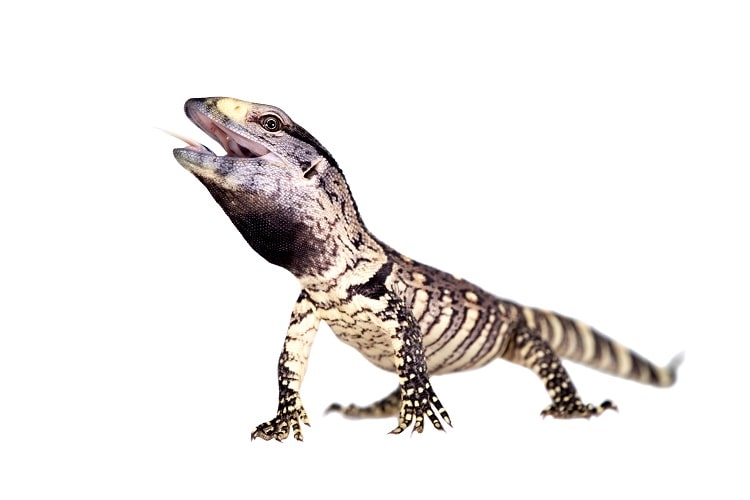
Black-throated monitors can be a little difficult to find since there is not a high demand for these lizards as pets. You might be able to find one for sale at a reptile expo, but you will likely need to search for a breeder online. To select a breeder, make sure to look at customer reviews, and make sure the breeder can answer any questions you have about the animals.
A good breeder will be able to instruct you on proper care, tell you the monitor’s hatch date, and will likely question you to be sure you are prepared for such a challenging pet. You should also request pictures and videos of the exact animal you want to check for signs of illness.
Finally, you need to be sure you are purchasing a captive-bred monitor. Black-throated monitors’ populations are threatened in the wild and purchasing a wild-caught reptile will only help contribute to the problem. In addition, captive-bred reptiles tend to be healthier and have better temperaments.
How Much Does A Black-Throated Monitor Cost?
Estimating the cost of a black-throated monitor and its setup can be quite difficult. They are very expensive pets, but you can save $2-$3k if you decide to give your monitor a room in the house rather than pay for a custom-built enclosure. They can be very difficult to find and are hard to breed, so expect to pay around $800-$1000 for the black-throated monitor itself.
After paying for the monitor, if you want to purchase a custom-built enclosure, you should save $2-$3k at a minimum. You will also need to budget about $60/month for the UVB bulbs, $60 every 2-3 months for the heating bulbs, $10-$50 for a water dish or pool big enough for the monitor to soak in, $100-$200/month for substrate, $100+ for rocks, logs, plants, and other décor (depending on how fancy you want to get), about $100 for a hide for your monitor, $30 for equipment like feeding tongs, thermometers, and hygrometers, and about $50-$75/month for feeding an adult black-throated monitor.
Black-Throated Monitor Facts
| Common Name (s) | Black-throated monitor, rock monitor, cape monitor |
| Scientific Name | Varanus albigularis ionidesi |
| Family Name | Varanidae |
| Genus Name | Varanus |
| Range | East African country of Tanzania |
| Adult Size | Up to 7 feet long and 60 lbs |
| Lifespan | 20+ years in captivity |
| Similar Species/Popular Alternatives | Savannah monitor, Ackie monitor, white-throated monitor, peach-throated monitor |
Summary
Being one of the largest lizards you can legally own, it is easy to see why many people are fascinated by the idea of keeping a black-throated monitor. However, because they are so expensive and grow to be so large, it is absolutely vital that you make sure you are prepared to handle such a challenge before adopting one of these prehistoric giants.
They need to be fed a large diet of rodents, insects, eggs, and other reptiles every day to every other day, and require a very large and expensive setup involving multiple heating and UVB lights. They are one of the tamest species of African monitors, but it is still recommended that you purchase your monitor as a baby to make sure you can properly socialize it before it becomes too large to handle. Did you find this article helpful in deciding whether or not you are prepared to adopt one of these massive lizards? Let us know!

